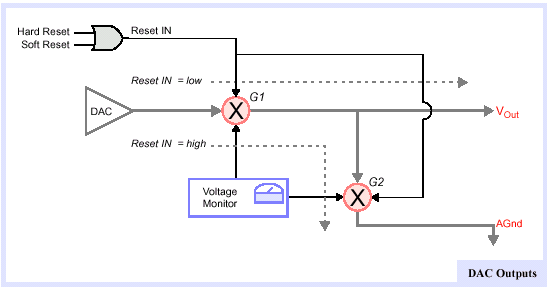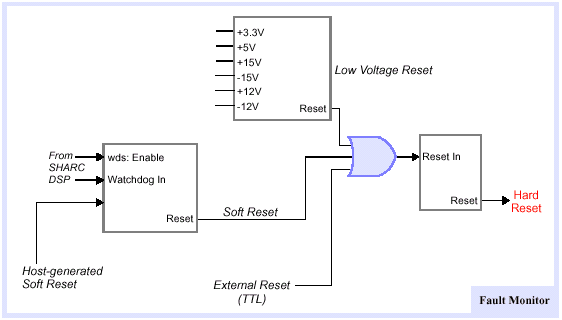| CHAPTER
6 XMP Controller Motion Drive I/O |
|
Faults and ResetsThe fault monitor circuitry detects faults and controls reset operations. ResetsXMP system resets can occur due to hard reset (hardware reset) or soft reset (software reset). The DAC (digital-to-analog converter) outputs are disabled after both Hard Reset and Soft Reset events. Hard Reset
Hard reset occurs 400ms after power-on or fail events, and 200ms after software reset or external reset events. The Hard Reset lasts 200-400 msec, leaving the DACs with Vout switched away from the DAC and tied to the DAC's analog ground. The first write from the SHARC to the DAC will cause this switch (Vout) to shift back to the DAC for normal operations. Soft ResetSoft resets are caused by a watchdog timeout from the DSP's flag output, or when the host writes a key sequence to the host system registers. External reset is triggered using an external TTL input. Both software and external resets are active low. To guarantee reset when Vcc is low, the triple OR gate will operate down to Vcc = +1V.
The software reset is handled by a Watchdog Timer with an adjustable timeout. The Watchdog Timer is intended to catch malfunctioning firmware. The Watchdog Timer does not monitor Vcc. The timer only responds to a timeout accompanied by a 200 ms reset. The Watchdog Timer is disabled during power-up, and following a reset of the SHARC DSP, allows the DSP to boot and begin instruction execution.
For the Soft Reset watchdog circuitry, a latched reset is used, which provides an added protection of not allowing a malfunctioning SHARC DSP to mistakenly write to the DAC (the Soft Reset is held until the host clears it, as part of the host's watchdog timeout recovery routine). Power Fail Control of DAC OutputsThe DAC has embedded analog switches in the output stage. The analog switches G1 and G2 are controlled by the on-chip voltage monitor and by the dedicated reset input pin (Reset IN). A low voltage on the Reset IN input will cause G1 to open and G2 to close, clamping Vout to AGnd via a low impedance path (typically 1K ohms). This condition will remain until the reset input goes high and a valid word is written into the DAC. DAC output protection.
The Reset IN input is the active low OR'ed condition of Hard Reset or Soft Reset.
A 65K ohm resistor from Vout to AGnd will maintain 0 volts on Vout until the supplies reach +1 volt. What happens if we lose an analog power rail? The Reset IN input will go low once one of our rails crosses the reset threshold. The Reset IN input is valid for Vdd and Vss to +1.2 volts, and below those voltage levels, the 65K ohm pulldown resistor protects the circuit. |
|
